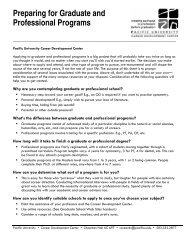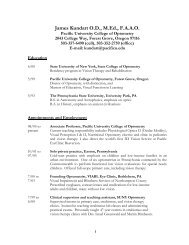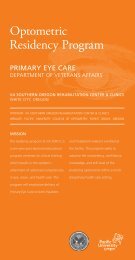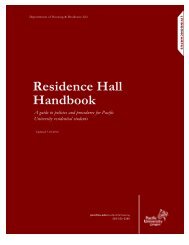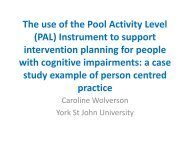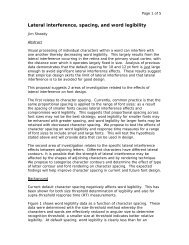Love & Logic Brochure - Early Learning Community
Love & Logic Brochure - Early Learning Community
Love & Logic Brochure - Early Learning Community
Create successful ePaper yourself
Turn your PDF publications into a flip-book with our unique Google optimized e-Paper software.
Our Reflection<br />
On the whole, all of us found this book to be full of<br />
good ideas and valuable for beginning teachers. We<br />
appreciated that it provided concrete examples and<br />
emphasized the importance of giving choices in the<br />
classroom. It seems to be adaptable across multiple<br />
grade levels and provides real-life examples and<br />
specific phrases that will enable us to put a theory into<br />
action. Additionally, many of our mentor teachers<br />
have heard of this book and use some aspect of it in<br />
their classrooms.<br />
Pros<br />
It gives students choices and empowers them.<br />
It provides solutions to real situations.<br />
Less theory and more practical examples.<br />
It places the responsibility on the person who<br />
owns the problem.<br />
Provides ways to diffuse power struggles.<br />
Encourages educators to define their style of<br />
teaching.<br />
It gives control to students regarding their<br />
own life and education.<br />
Cons<br />
Some examples seem manipulative.<br />
Requires modification for younger grades.<br />
Depending upon interpretation and<br />
application, this can be either studentcentered<br />
or teacher-centered.<br />
Some examples seem to over-simplify the<br />
real-world situations.<br />
What do you do with the student for whom<br />
it doesn’t work<br />
A lot of the book was not written by Jim Fay<br />
who is the original founder of <strong>Love</strong> and<br />
<strong>Logic</strong>.<br />
Resources<br />
http://www.loveandlogic.com<br />
1-800-338-4065<br />
Weekly e-mail tips<br />
Articles<br />
Video Clips<br />
Conferences for Parents & Educators<br />
Other Books by Jim Fay:<br />
Parenting with <strong>Love</strong> and <strong>Logic</strong><br />
Toddlers & Pre-schoolers: <strong>Love</strong> and <strong>Logic</strong> Parenting<br />
for <strong>Early</strong> Childhood<br />
Pearls of <strong>Love</strong> and <strong>Logic</strong> for Parents and Teachers<br />
Parenting Teens with <strong>Love</strong> and <strong>Logic</strong><br />
Meeting the Challenge<br />
From Innocence to Entitlement<br />
Grandparenting with <strong>Love</strong> and <strong>Logic</strong><br />
<strong>Brochure</strong> produced by:<br />
Suzy Chapman, Amy Clark, Lisa Davies, Ana<br />
McKeen, and Cindy West<br />
Teaching With <strong>Love</strong> &<br />
<strong>Logic</strong><br />
What is <strong>Love</strong> and <strong>Logic</strong><br />
“Children learn the best lessons when they're given a<br />
task and allowed to make their own choices (and fail)<br />
when the cost of failure is still small. Children's failures<br />
must be coupled with love and empathy from their<br />
parents and teachers.”<br />
Who’s Behind It<br />
Jim Fay - founder and former school principal<br />
Foster W. Cline, M.D. - founder and psychiatrist<br />
Charles Fay, Ph.D. - school psychologist<br />
Why Does It Work<br />
Uses humor, hope, and empathy to build up the<br />
adult/child relationship<br />
Emphasizes respect and dignity for both children<br />
and adults<br />
Provides real limits in a loving way<br />
Teaches consequences and healthy decision-making
Three Rules of <strong>Love</strong> and <strong>Logic</strong><br />
Use Enforceable Limits<br />
Requires that children have implied choices and be<br />
forced into thinking mode.<br />
A matter of telling students how you will be running<br />
your life: makes things worse when you tell students<br />
how to run their lives.<br />
Provide Choices within Limits<br />
Humans have a strong need for control and L&L<br />
teachers know how to share control.<br />
Offer students a portion of the control upfront on<br />
your terms so that the student’s self-respect remains<br />
intact.<br />
Apply Consequences with Empathy<br />
“The effective teacher administers consequences with<br />
empathy and understanding, as opposed to anger and<br />
lecture.”<br />
Children learn from their mistakes when: They<br />
experience the consequences of their mistakes and<br />
adults in their environment provide empathy.<br />
Four Principles of <strong>Love</strong> and <strong>Logic</strong><br />
Enhancement of Self-Concept<br />
Students tend to respond to covert messages more<br />
than overt.<br />
Establish relationships of unconditional acceptance<br />
and respect with students even if you have to reject<br />
their questionable behavior.<br />
Students need to be given opportunities to struggle<br />
and solve their own problems. This shows they are<br />
capable.<br />
Allow students to own their feelings so they reside in<br />
them rather than being dependent on how somebody<br />
else feels about them.<br />
Shared Control<br />
The more control you give away, the more you<br />
get in return. Take only what you need and<br />
leave some for the student.<br />
Obtain students’ cooperation vs. controlling<br />
them.<br />
“Choices Within Limits”<br />
o Choices must be legitimate<br />
o Choices need to be equally acceptable<br />
o Choices need to given with equal “pizzazz”<br />
The same limits can be set using fighting words<br />
and thinking words, but the reaction each<br />
inspires is different.<br />
Consequences with Empathy<br />
Consequences need to be served up with<br />
compassion, empathy, or understanding, rather<br />
than anger.<br />
The difference between consequences and<br />
punishments is where we interpret the pain<br />
emanating from. Consequences result in pain<br />
coming from the inside; punishment results in<br />
pain coming from the outside.<br />
Process of Change:<br />
o There is a problem<br />
o Identify whose problem it is<br />
o Show empathy<br />
o Offer a positive relationship message<br />
Goal of L&L is to help kids become wise.<br />
Students respond positively to a penalty when<br />
they see a logical connection between their<br />
behavior and what happens to them as a result<br />
of their behavior.<br />
Make consequences as close to the time and<br />
place of the infraction as possible.<br />
Give the student the opportunity to be involved<br />
in the solution/decision making.<br />
Administer consequences with calm interest.<br />
Demonstrate problem-solving techniques.<br />
Allow students to feel empowered.<br />
Shared Thinking<br />
Students should do more thinking than the adult.<br />
Engaging in thinking demonstrates to ourselves that<br />
we are capable.<br />
Questions need to be legitimate not rhetorical.<br />
Students should be involved in making decisions that<br />
affect their lives.<br />
If given sufficient time, students often come to the<br />
same conclusion as an adult.<br />
Styles of Teaching<br />
Helicopters<br />
Primary goal is to “hover and rescue”<br />
Do students’ thinking and work for them<br />
Tend to whine and complain<br />
Drill Sergeants<br />
Thrive on having power over others<br />
Make lots of demands and tell students how<br />
they should behave<br />
Threaten<br />
Consultants<br />
Most stratifying teaching style according to<br />
L&L<br />
These teachers are in education for a purpose:<br />
they love kids and they love learning<br />
Listen to students and provide choices



